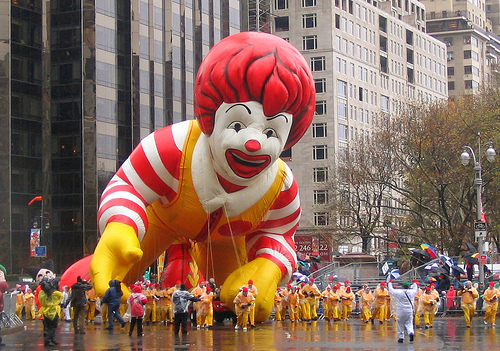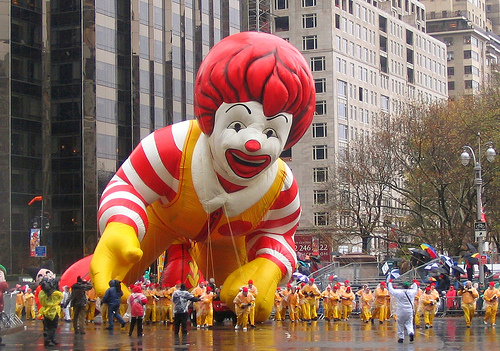Send your question to Umbra!
Q. Dear Umbra,
After close to 50 years of hawking fatty food directly to kids, a groundswell of parents, health experts, and children’s advocates are calling on McDonald’s to retire Ronald McDonald. A new report and national poll released by Corporate Accountability International found that close to half of the public favors the clown’s retirement. What do you think?
Myriah
Boston
A. Dearest Myriah,
 Did you happen to catch one of Grist‘s (sadly) more believable April Fools’ articles last week? Who knew so many people would actually believe that McDonald’s food wouldn’t break down in 1,000 years? Perhaps it was this stranger-than-fiction, 1-year-old Happy Meal that made it all the more plausible.
Did you happen to catch one of Grist‘s (sadly) more believable April Fools’ articles last week? Who knew so many people would actually believe that McDonald’s food wouldn’t break down in 1,000 years? Perhaps it was this stranger-than-fiction, 1-year-old Happy Meal that made it all the more plausible.
For context, dearests, Corporate Accountability International, with its Retire Ronald campaign, is comparing RM to the likes of previous kid-geared corporate characters like Joe Camel and Spuds MacKenzie (BTW, as a wee lass, I once waited for two hours at a chicken wings restaurant for that Bud Light–hawking dog to sign a poster for me; sadly, or perhaps fortunately, he never showed and my affinity soon wore thin).
As for Ronald, while I find clowns in general creepy and clowns marketing a product to children really creepy (check out his note to readers at Ronald.com: “Hey, kids. This is advertising!”), Ronald McDonald is not the real problem. Happy Meals don’t need a floppy-shoed shill; they’re kid-friendly versions of McCuisine in colorful bags, plastic toy included.
And kids are not the ones forking over the money to buy Happy Meals, for the most part—their parents are. Thusly, a campaign to educate parents about the food they put in their kids’ mouths seems a better use of time and money than simply asking a clown to retire, even though I’m generally a fan of clever provocation.
I chatted with Grist’s own grand poobah of food, Tom Philpott, who thinks the most direct way to support the movement is to rally around school lunch reform. We teach kids to read, write, and do math in schools, but we also teach them how to eat. And what we’re teaching them now is that industrial crap is food. Janet Poppendieck, author of Free for All: Fixing School Food in America, wrote a rad blog post about how to let your voice be heard on the matter. Contact your senators and representatives, who’ll soon be having their say on the Child Nutrition Reauthorization legislation, which controls school lunches and other nutrition programs. Tell them exactly what you want and why it’s so important to you.
I’d also suggest taking a page from Michelle Obama’s playbook, even though we don’t have the same platform she does: As part of her campaign against childhood obesity, in addition to a revamping of the school lunch program, she’s planning a boost in funding for farmers markets, a major initiative to “end” food deserts by 2017, a focus on maintaining children’s exercise levels, and a set of broad public-private partnerships, along with reforms to front-of-package nutrition labeling and the food pyramid. Whew, I’m tired just thinking about it all, but I’m energized by her ambition nonetheless. You can join the First Lady’s Let’s Move campaign for tips, strategies, and updates.
Also, it sounds simple, but just don’t buy fast food for your own kids. Flip off the TV, stow away the video games, and force them outside. Better yet, go with them. Lead by example, and you won’t have to worry about some crazy-looking clown doing it for you.
Nutritiously,
Umbra
Q. Dear Umbra,
Hello! This is Ian. I’ve been designing a card game recently. I’m 9. I’m nearing the final touches, and one of them is packaging and producing the actual product. I really want to make it eco-friendly, but I’m struggling with how. Basically, I’m wondering how I could find the local (I live in Bismarck) resources to create eco-friendly paper, dice, and packaging without too much expense. Thanks!
Ian
Bismarck, N.D.
A. Dearest Ian,
Goodness me, you’re an industrious fellow. You know, I actually made trivia board games when I was kid, based on research from my set of World Book Encyclopedias. The categories were always the same: birds, dinosaurs, and presidents. Did you know that Pres. John Tyler had more children than any other U.S. president? He whelped (look it up) a whopping 15 kiddos. Sadly, Ian, you’ll probably never know the joy of owning a set of encyclopedias, much less researching the presidents in them. Sigh.
Anywho, I wonder, are you planning to market and sell the game on your own? Is it for personal use? Or are you hoping to pitch the prototype to a company to market and sell for you? I think I have a solution that may work in any case.
I personally love it when I find items packaged in recycled boxes and recycled wrapping paper—perhaps old newspapers, magazines, saved paper from holiday gifts. It’s really cool and more personal when every package is slightly different.
As for dice, what I did for my games may get you in trouble, but I just borrowed from other board games around the house. Of course, annoyed family members looking for missing dice can be a hazard of this method. Another solution is secondhand shopping for old board games—they may be missing some pieces, but that’s just fine for your purposes. You can use the dice, game pieces, and even the box (perhaps covered in recycled wrapping paper) for your own game.
Good luck, Ian! I’d love to see the finished product when it’s ready.
Gamely,
Umbra
Q. Dear Umbra,
I would suggest to the coffee guy to put in the milk and sugar first—adding the hot coffee mixes everything up well.
Keep up the good work with your column!
Jack
Zurich, Switzerland
A. Dearest Jack,
Great suggestion! I used it this morning with my tea-and-rice-milk combo, and it worked beautifully. Readers, keep the tips coming. I adore drawing from your vast collective wisdom and experience.
Thankfully,
Umbra



